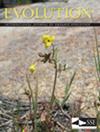Untangling the colonization history of the Australo-Pacific reed warblers, one of the world's great island radiations.
IF 3.1
2区 环境科学与生态学
Q2 ECOLOGY
引用次数: 0
Abstract
Island radiations, such as those of the Australo-Pacific, offer unique insight into diversification, extinction, and early speciation processes. Yet, their speciation and colonization histories are often obscured by conflicting genomic signals from incomplete lineage sorting or hybridization. Here, we integrated mitogenomes and genome-wide SNPs to unravel the evolutionary history of one of the world's most geographically widespread island radiations. The Australo-Pacific reed warblers (Acrocephalus luscinius complex) are a speciose lineage including five species that have become extinct since the 19th century and ten additional species of conservation concern. The radiation spans over 10,000 km across Australo-Papua, Micronesia and Polynesia, including the Mariana, Hawaii and Pitcairn Island archipelagos. Earlier mtDNA studies suggested a stepping-stone colonization process, resulting in archipelago-level secondary sympatry of divergent mtDNA lineages in the Mariana Islands and Marquesas. These studies hypothesised that morphologically similar species on neighbouring islands arose from ecological convergence. Using hDNA from historical museum specimens and modern genetic samples, we show that incomplete lineage sorting and/or gene flow have shaped the radiation of Australo-Pacific reed warblers rather than secondary sympatry. The nuclear genome reconstructs a simpler biogeographic history than mtDNA, showing close relationships between species in the Mariana Islands and Marquesas despite their paraphyletic mtDNA lineages. Gene flow likely involved early and late colonizing waves of the radiation before the loss of ancestral dispersive ability. Our results highlight how collection genomics can elucidate evolutionary history and inform conservation efforts for threatened species.解开世界上最伟大的岛屿辐射之一--澳大利亚-太平洋芦苇莺的殖民历史。
岛屿辐射(如澳太地区的岛屿辐射)为了解物种多样化、灭绝和早期物种形成过程提供了独特的视角。然而,它们的物种演化和殖民历史往往被不完全的品系分类或杂交所产生的相互矛盾的基因组信号所掩盖。在这里,我们整合了有丝分裂基因组和全基因组SNPs,以揭示世界上地理分布最广的岛屿辐射之一的进化历史。澳大利亚-太平洋芦苇莺(Acrocephalus luscinius complex)是一个物种谱系,包括自19世纪以来已经灭绝的5个物种和另外10个受保护的物种。其辐射范围横跨澳大利亚-巴布亚、密克罗尼西亚和波利尼西亚,包括马里亚纳群岛、夏威夷群岛和皮特凯恩岛群岛,总长度超过 1 万公里。早期的 mtDNA 研究表明,在马里亚纳群岛和马克萨斯群岛,不同的 mtDNA 系在群岛水平上的次生共生是一个阶梯式的殖民过程。这些研究假设,相邻岛屿上形态相似的物种产生于生态趋同。利用来自历史博物馆标本和现代基因样本的 hDNA,我们表明,不完全的品系分类和/或基因流形成了澳太苇莺的辐射,而不是次生共生。与 mtDNA 相比,核基因组重建了一个更简单的生物地理历史,尽管马里亚纳群岛和马克萨斯群岛的 mtDNA 系属于旁系,但其物种之间的关系却很密切。基因流动可能涉及祖先分散能力丧失之前的早期和晚期辐射殖民浪潮。我们的研究结果突显了采集基因组学是如何阐明进化历史并为濒危物种的保护工作提供信息的。
本文章由计算机程序翻译,如有差异,请以英文原文为准。
求助全文
约1分钟内获得全文
求助全文
来源期刊

Evolution
环境科学-进化生物学
CiteScore
5.00
自引率
9.10%
发文量
0
审稿时长
3-6 weeks
期刊介绍:
Evolution, published for the Society for the Study of Evolution, is the premier publication devoted to the study of organic evolution and the integration of the various fields of science concerned with evolution. The journal presents significant and original results that extend our understanding of evolutionary phenomena and processes.
 求助内容:
求助内容: 应助结果提醒方式:
应助结果提醒方式:


